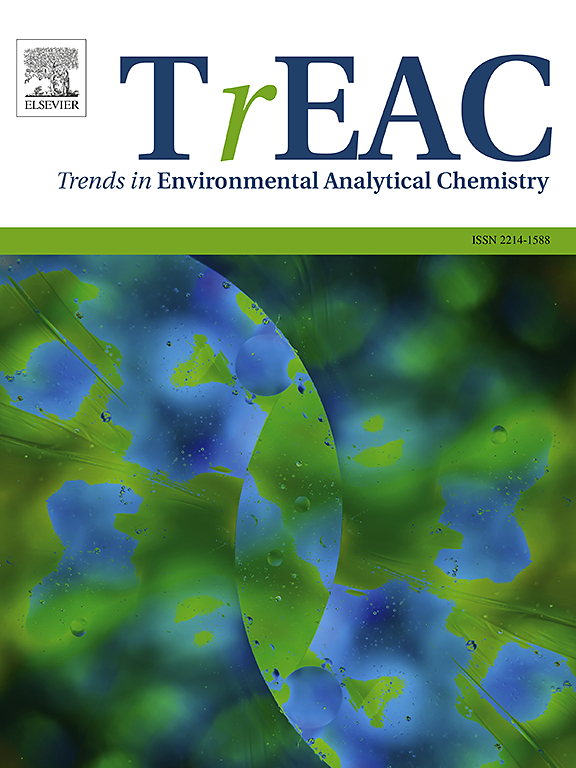Green solutions for clean water: Natural materials in contaminant detection and removal
IF 13.4
2区 化学
Q1 CHEMISTRY, ANALYTICAL
引用次数: 0
Abstract
The growing crisis of global water contamination, fueled by rapid industrialization, urban development, and intensified agriculture, has created an urgent need for sustainable, efficient, and environmentally friendly water treatment technologies. Conventional treatment approaches often fall short due to high operational costs, potential secondary pollution, and limited effectiveness against emerging pollutants. In response, green and natural materials have emerged as attractive alternatives for both contaminant removal and water quality monitoring, offering advantages such as biodegradability, ecological safety, cost-efficiency, and wide availability. This review provides a detailed overview of recent advancements in utilizing plant-based adsorbents, agricultural and industrial bio-wastes, natural polymers, clays, algae, microbial biomass, and eco-friendly nanomaterials for water purification. It explores key removal strategies including adsorption, photocatalytic degradation, membrane filtration, bio-based coagulation-flocculation, and bioremediation, demonstrating their effectiveness in targeting heavy metals, organic pollutants, biological contaminants, microplastics, and newly recognized environmental toxins. Furthermore, the integration of these natural materials into portable, low-cost sensing technologies—such as colorimetric, electrochemical, and fluorescent biosensors—is examined, offering innovative tools for real-time contaminant detection. The review also highlights emerging hybrid systems that combine green nanomaterials with biochar, biopolymers, and metal-based nanoparticles to enhance contaminant removal and multifunctional performance. Key practical considerations, including scalability, material uniformity, environmental impacts, biodegradability, and regulatory challenges, are addressed. A life cycle assessment (LCA) perspective is incorporated to compare the sustainability of these green alternatives with conventional materials. The article concludes by outlining future research opportunities focused on hybrid technologies, smart sensing integration, and circular economy frameworks to support scalable, sustainable, and decentralized water purification solutions.
清洁水的绿色解决方案:污染物检测和去除中的天然材料
快速工业化、城市发展和集约化农业加剧了全球日益严重的水污染危机,迫切需要可持续、高效和环境友好的水处理技术。由于操作成本高,潜在的二次污染以及对新出现的污染物的有效性有限,传统的处理方法往往不足。因此,绿色和天然材料已成为污染物去除和水质监测的有吸引力的替代品,具有可生物降解性、生态安全性、成本效益和广泛可用性等优点。本文综述了近年来利用植物吸附剂、农业和工业生物废弃物、天然聚合物、粘土、藻类、微生物生物量和生态友好型纳米材料进行水净化的研究进展。它探讨了包括吸附、光催化降解、膜过滤、生物基混凝絮凝和生物修复在内的关键去除策略,展示了它们在重金属、有机污染物、生物污染物、微塑料和新发现的环境毒素方面的有效性。此外,将这些天然材料整合到便携式、低成本的传感技术中,如比色、电化学和荧光生物传感器,为实时污染物检测提供了创新工具。该综述还强调了新兴的混合系统,将绿色纳米材料与生物炭、生物聚合物和金属基纳米颗粒结合起来,以增强污染物去除和多功能性能。关键的实际考虑因素,包括可扩展性、材料均匀性、环境影响、生物降解性和监管挑战。采用生命周期评估(LCA)的观点来比较这些绿色替代品与传统材料的可持续性。文章最后概述了未来的研究机会,重点是混合技术、智能传感集成和循环经济框架,以支持可扩展、可持续和分散的水净化解决方案。
本文章由计算机程序翻译,如有差异,请以英文原文为准。
求助全文
约1分钟内获得全文
求助全文
来源期刊

Trends in Environmental Analytical Chemistry
Chemistry-Analytical Chemistry
CiteScore
21.20
自引率
2.70%
发文量
34
审稿时长
44 days
期刊介绍:
Trends in Environmental Analytical Chemistry is an authoritative journal that focuses on the dynamic field of environmental analytical chemistry. It aims to deliver concise yet insightful overviews of the latest advancements in this field. By acquiring high-quality chemical data and effectively interpreting it, we can deepen our understanding of the environment. TrEAC is committed to keeping up with the fast-paced nature of environmental analytical chemistry by providing timely coverage of innovative analytical methods used in studying environmentally relevant substances and addressing related issues.
 求助内容:
求助内容: 应助结果提醒方式:
应助结果提醒方式:


